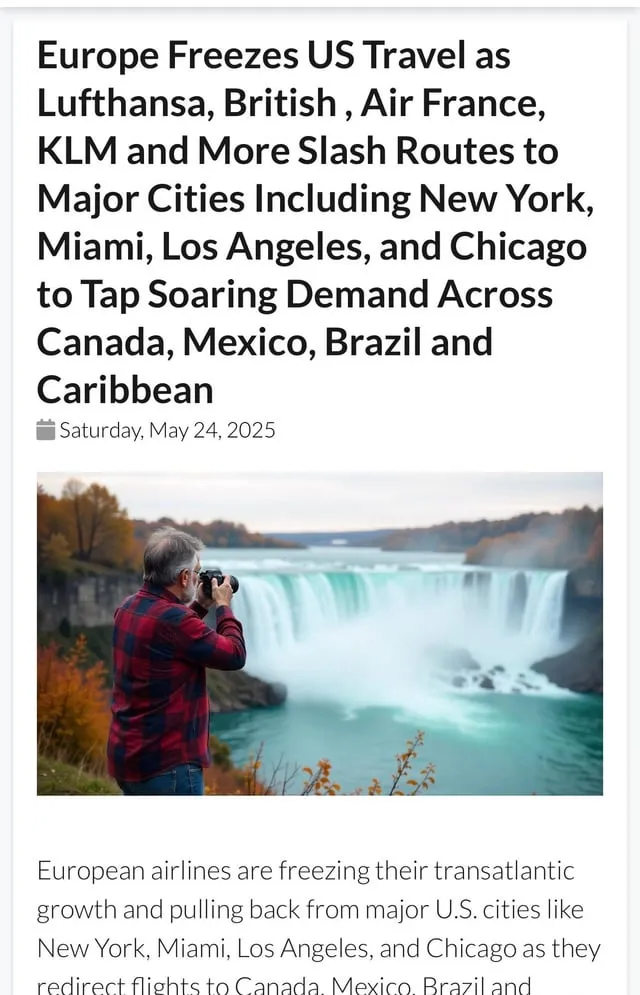European Airlines Slash U.S. Flights: The Implications for Tourism and Economy
In a concerted move that is sending shockwaves through the U.S. tourism industry, major European airlines such as Lufthansa, British Airways, Air France, and KLM have announced significant reductions in flight routes to several key American cities, including New York, Miami, Los Angeles, and Chicago. This decision appears to be driven by a combination of soaring demand across Canada, Mexico, Brazil, and the Caribbean, along with challenges faced by the aviation sector in the wake of the COVID-19 pandemic.
Understanding the Shift in Flight Routes
The reduction in U.S. flight routes by European airlines marks a strategic pivot towards addressing an increasing demand in neighboring regions. Airlines are reallocating their resources, targeting markets that offer a more stable financial landscape post-pandemic. Industry experts suggest several contributing factors to this shift:
- Increased demand for travel in Canada and Latin America.
- Operational challenges such as staffing shortages and fluctuating fuel prices in the U.S.
- Changing consumer behaviors and travel preferences post-COVID.
The Economic Fallout: A Potential $23 Billion Loss
A recent study has sounded alarms about the economic repercussions of decreased international travel. If the trend continues, the U.S. could potentially lose a staggering $23 billion in GDP and about 230,000 jobs primarily in the tourism and hospitality sectors. The outlook is particularly concerning as the tourism industry represents a significant portion of the American economy. This loss could lead to:
- Decline in local businesses reliant on tourist spending.
- Job losses within the hospitality sector, including hotels, restaurants, and travel services.
- Reduced tax revenue for state and local governments, impacting public services.
The 2025 U.S. Tourism Slump: Preparing for Financial Impact
The ramifications of decreased international travel cannot be understated, particularly as projections suggest a substantial tourism slump might stretch into 2025. For many households, this could mean a direct impact on retirement savings and overall financial stability. Here are four actionable steps that individuals and families can take to prepare for potential economic challenges:
- Diversify Investment Portfolios: Consider reallocating your investment portfolio to safeguard against market volatility. Speaking with a financial advisor can provide insights on potential opportunities in diverse sectors.
- Explore Local Vacation Options: With international travel becoming less accessible, look for local travel opportunities, which can also stimulate the domestic economy.
- Monitor Economic Indicators: Stay informed about economic indicators related to the tourism and hospitality sectors. Understanding market trends can help in making timely financial decisions.
- Boost Emergency Savings: Increasing your emergency fund can offer a buffer during times of economic uncertainty, providing peace of mind.
Industry Reactions and Strategies
Airlines and travel agencies are scrambling to navigate the new landscape. Some have begun seeking partnerships within the Americas to enhance their route offerings and tap into previously underserved markets. Airlines like United and American are looking at ways to fill the gap left by European competitors. Moreover, local governments and tourism boards are exploring initiatives to attract domestic tourists and promote regional travel.
The travel and hospitality industry is advocating for government support in the form of stimulus packages and marketing initiatives that can incentivize domestic and international travel. Cooperative marketing campaigns with neighboring countries can also play a pivotal role in mending the travel ecosystem.
The Future of U.S. Tourism
While the current reductions in flight routes from European airlines have ignited concerns for the U.S. economy and the travel sector, they also present opportunities for reinvention and growth within the industry. Local destinations can benefit from heightened interest in domestic travel, and this might lead to the development of new attractions and services designed to cater to American tourists.
Engagement with travel influencers and digital marketing strategies can also change the narrative surrounding American tourism. Results from ongoing market analysis will help shape how the industry responds to current challenges and what steps need to be taken to restore confidence in international travel.
Conclusion
As European airlines make significant cuts to U.S. flight routes, the implications for the American economy and tourism sector are considerable. With the potential loss of billions in GDP and hundreds of thousands of jobs, now is the time for individuals, businesses, and government entities to act. Those who prepare for the ensuing changes and invest strategically in their resources will likely weather the storm and emerge more resilient. The ability to pivot and adapt will be essential in navigating this turbulent time for travel and tourism as the world continues to rebound from global uncertainties.







